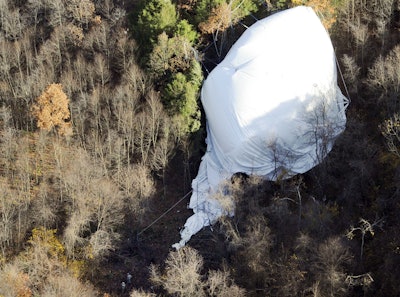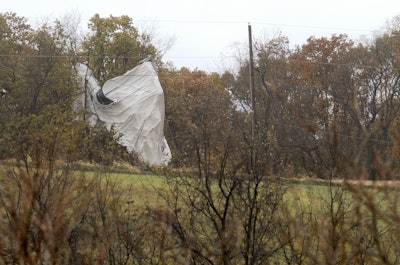
The Army radar blimp that broke loose in October and caused more than $300,000 in damage went on its 160-mile journey through the Pennsylvania countryside because it was out of batteries. The blimp will be replaced and the program will continue, the U.S. Department of Defense announced.
According to information obtained by the Los Angeles Times, one of two blimps (or aerostats) being tested on the Aberdeen Proving Ground broke loose on Oct. 28 due to “design, human and procedural issues.” Namely, there were no batteries to power the automatic-deflation system.
The 242-foot, 7,000-pound surveillance blimp — which floated at about 5,200 feet before it broke loose that breezy day — is part of the $2.7 billion Joint Land Attack Cruise Missile Defense Elevated Netted Sensor System (JLENS) program. Manufactured by Raytheon, JLENS is supposed to be able to detect threats from as far as 340 miles away.
While undergoing tests to determine if JLENS could effectively guard the Washington, D.C. area — which suffered a number of issues before the blimp escape — a device responsible for monitoring air pressure inside the aerostat malfunctioned.
 (AP Photo)
(AP Photo)In cases of high winds, the device, known as a pitot tube, is supposed to trigger fans to bolster air pressure inside the aerostat. On Oct. 28, however, the fans did not turn on, despite the 70-mph winds. The craft, vulnerable and malleable in the wind, spun into an undesirable position and was bent out of shape by the wind, which increased tension on its tether until it broke loose.
With the tether — and power source — severed, the craft should have deflated itself and returned to the ground within two miles. “The lack of batteries prevented the automatic rapid deflation device from deploying,” said Michael Kucharek, a spokesperson for the North American Aerospace Defense Command and the U.S. Northern Command.
 (AP Photo)
(AP Photo)Instead, the blimp returned to the ground after 160 miles and about 100 shotgun shells.
Although the program is slated to continue, officials with the project have asked Congress for an additional $27 million to get JLENS back in the skies by Oct. 1.
Do you think the JLENS program should be restored? Should Congress grant the project the requested additional funds? Comment below or tweet @MNetKatie.






















